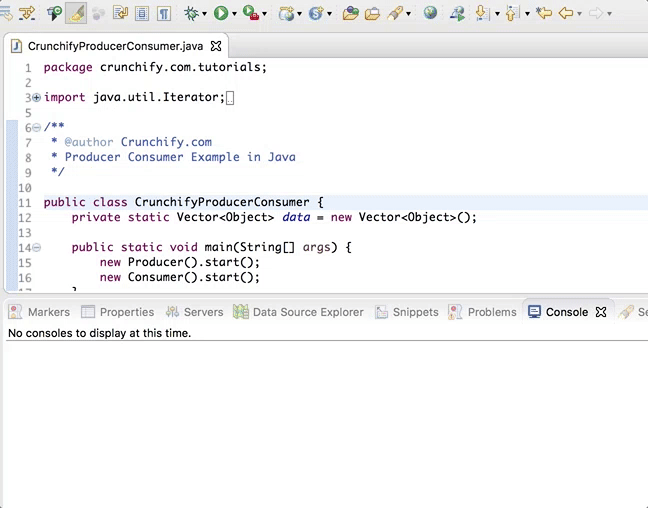
The producer-consumer problem (also known as the bounded-buffer problem) is a classic Java Example of a multi-process synchronization problem.
The problem describes two processes, the producer and the consumer, who share a common, fixed-size buffer used as a queue. The producer’s job is to generate a piece of data, put it into the buffer and start again.
At the same time, the consumer is consuming the data (i.e., removing it from the buffer) one piece at a time. The problem is to make sure that the producer won’t try to add data into the buffer if it’s full and that the consumer won’t try to remove data from an empty buffer.
Below simple Java Program will create this problem:
Java Examples – Producer Consumer Problem
package com.crunchify.tutorials;
import java.util.Vector;
import java.util.Iterator;
/**
* @author Crunchify
*/
public class CrunchifyProducerConsumer {
private static Vector<Object> data = new Vector<Object>();
public static void main(String[] args) {
new Producer().start();
new Consumer().start();
}
public static class Consumer extends Thread {
Consumer() {
super("Consumer");
}
@Override
public void run() {
for (;;) {
try {
Thread.sleep(1);
} catch (Exception e) {
e.printStackTrace();
}
@SuppressWarnings("rawtypes")
Iterator it = data.iterator();
while (it.hasNext())
it.next();
}
}
}
public static class Producer extends Thread {
Producer() {
super("Producer");
}
@Override
public void run() {
for (;;) {
try {
Thread.sleep(1);
} catch (Exception e) {
e.printStackTrace();
}
data.add(new Object());
if (data.size() > 1000)
data.remove(data.size() - 1);
}
}
}
}
Issue:
Exception in thread "Consumer" java.util.ConcurrentModificationException
at java.util.ArrayList$Itr.checkForComodification(ArrayList.java:819)
at java.util.ArrayList$Itr.next(ArrayList.java:791)
at com.crunchify.tutorials.CrunchifyProducerConsumer$Consumer.run(CrunchifyProducerConsumer.java:36)
Resolution:
Add the keyword synchronized to put a lock on the data while we are using it.
Better Java Program:
package crunchify.com.tutorials;
import java.util.Iterator;
import java.util.Vector;
/**
* @author Crunchify.com
* Producer Consumer Example in Java
*/
public class CrunchifyProducerConsumer {
private static Vector<Object> data = new Vector<Object>();
public static void main(String[] args) {
new Producer().start();
new Consumer().start();
}
public static class Consumer extends Thread {
Consumer() {
super("Consumer");
}
@SuppressWarnings("rawtypes")
@Override
public void run() {
for (;;) {
try {
Thread.sleep(1000);
System.out.println("Object Consumed ################");
} catch (Exception e) {
e.printStackTrace();
}
synchronized (data) {
Iterator it = data.iterator();
while (it.hasNext())
it.next();
}
}
}
}
public static class Producer extends Thread {
Producer() {
super("Producer");
}
@Override
public void run() {
for (;;) {
try {
Thread.sleep(1000);
System.out.println("Object Produced ~~~~~~~~~~~~~~~");
} catch (Exception e) {
e.printStackTrace();
}
data.add(new Object());
if (data.size() > 1000)
data.remove(data.size() - 1);
}
}
}
}
Java Producer Consumer Example Result:

